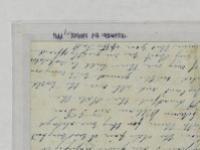By using The Curtis Family Letters, students explore the reasons for Irish emigration from Ireland and the impact that immigration had on the family. Students learn about the hardships in Ireland and the challenges faced in the United States. From the information wanted ads in the Catholic Herald, students gain an understanding of the role of the Church in community building and family reorganization in America. Students build a profile of the young Irish immigrant from these ads, recognize the fragmented state of Irish families, and understand the difficulties they faced when trying to reunite.
Irish Immigrant Letters Home
Irish Immigrant Letters Home
Essential Questions
Objectives
Students will:
- Be able to explain the historical importance of Irish Immigration to Pennsylvania in the 19th century.
- Use critical thinking to analyze primary sources from Irish Immigrants.
- Understand the factors that led to high Irish Immigration during the 19th century.
- Use critical thinking to analyze the patterns of Irish Immigration during the 19th century.
- Use critical thinking skills to analyze the differences between life in Ireland and Pennsylvania for Irish immigrants during the 19th century.
Primary Sources
Other Materials
Suggested Instructional Procedures
1. Assessing Prior Knowledge: Students brainstorm why people might move from one city to another or from one country to another. List the push/pull responses on the board.
2. Historical Overview: Drawing on the students’ background reading as well as the list of push/pull factors, give an overview of Irish immigration to Pennsylvania, using Guiding questions:
- Why did the Irish emigrate from Ireland?
- What did they hope to find in America?
When the class answers these questions, make connections to the list of push/pull factors on the board. Discussion should include the Potato Famine of 1846-47 and the religious and political turmoil in Ireland. Once the class has discussed why the Irish immigrated, students should explore how they settled in Pennsylvania. Students should use the Catholic Herald Information Wanted Ads to assess the migration patterns of Irish immigrants in the 19th century.
3. Study Curtis Letters
- Discuss the story of the family
- Explain the conventions of 19th century letter writing
- On reading the Curtis family letters with students: Reading nineteenth-century letters may present several challenges to students and teachers should be prepared to explain aspects of the Curtis letters that differ from our letters today. These include:
- Conventions of language: Dear Brother, openings and closings,
- Spelling: alternative spellings of words, bad spellings due to low educational level, unexpected capitalizations
- Punctuation: the Curtis letters contain little to no punctuation. Here we have transcribed the letters as they appear in the original. Teachers have the option of punctuating letters, or having students do so.
- Unfamiliar references: place names, personal names, abbreviations
- Have students use the worksheet to guide them through a close reading of the letter text. First have students read over the questions on the worksheet. Have students highlight the parts of the letter that they think answer each question. They should write the number of the question in the margin of the letter next to their highlighted information. Once they have read through and highlighted all of the letters, they are then ready to synthesize the information and answer the questions on the worksheet. Regroup as a class and identify themes in the letters that relate to the background presentation on Irish immigration.
4. John and Jane Curtis Write Home
- Posing as John or Jane Curtis in Pennsylvania in the mid 19th century, students write a mock letter home to one of their relatives in Ireland. In this letter, the student should describe:
- Where they are living in Pennsylvania and what this place is like
- The kind of work they are doing, what tasks are entailed in this work, how they are paid, how they are treated by their employer possibilities include: canal or railroad work, domestic service, mine work, farming
- Their feelings about their immigration experience, how they feel about being away from Ireland and being in Pennsylvania
- Have John or Jane address some of the issues in the letters sent to them such as money, passage, reason they haven’t written home sooner, information about other relatives.
- Alternatively, match students into pairs. One student role-plays an Irish immigrant, the other a family member remaining home in Ireland. Students write letters to one another and then change places.
5. Conclusion: As a class, read the actual letter from John and Jane Curtis to their mother in Ireland. Have students compare the tone and content of the letter from America to the other letters they have read. What do Jane and Aunt Mary seem to want to convey to Bridget Dunne Curtis in their letter? Students should think about the burdens of the family members in America and their need to address the issues of aid and support to their relatives in Ireland.
6. Expansion Activities
- Have students gather, read and share letters from their own families and compare them to the Curtis Family Letters.
- Visit the Irish Memorial at Penn’s Landing: http://www.irishmemorial.org/
- Have students create their own information wanted ads for John or Jane Curtis using their knowledge of the family and the relevant dates from the letters.
Vocabulary
Coffin Ship: a term given to the ships that carried Irish immigrants escaping from the potato famine. The name reflects the dangers immigrants faced in the form of disease and poor nutrition
Diaspora: refers to any people or ethnic population who have left or been forced to leave their traditional homeland and are dispersed throughout the world.
Discrimination: unfair treatment of a person or group (either intentional or unintentional) based on race, color, national origin, religion, sex, handicap, or other attribute.
Emigrant: someone who leaves one country to settle in another
Erin: ancient Gaelic name of Ireland. Nineteenth century nationalists used this term.
Famine: widespread starvation in Ireland was also called the Irish Potato Famine of 1845-49, The Great Famine, or The Great Hunger. British economic policy towards Ireland and a potato fungus that ravaged the crop resulted in mass starvation.
Immigrant: a person who comes to a country where they are not born in order to settle there.
Migration: the movement of persons from one country or locality to another
Nativism: anti immigrant sentiment or a sociopolitical policy favoring the interests of established inhabitants over those of immigrants. Historically refers to white, native-born, Protestant Americans' hostile and defensive reaction to European immigrants
Paddy: used as a disparaging term for a person, especially a man, of Irish birth or descent.
Related Resources for Students
Books:
- Gallagher, Carol. The Irish Potato Famine (Great Disasters: Reforms and Ramifications). Chelsea House Publishing, 2001.
- O’Hara, Megan. Irish Immigrants, 1840-1920 (Coming to America). Blue Earth Books, 2001.
- Schneider, Mical. Annie Quinn in America. Carolrhoda Books, 2001 [historical fiction]
- Watts, J.F. and Sandra Stotsky, eds. The Irish Americans (Immigrant Experience).Chelsea House Publishing 1995.
Videos:
- Irish-American Heritage. Wynnewood, PA: Schlessinger Video, 1997. (25 min.)
- The Irish in America: Long Journey Home. Burbank, CA: Buena Vista, 1998. 4 videocassettes (6 hours)
- Out of Ireland: the Story of Irish Emigration to America. New York: Shanachie Entertainment, 1997. (95 min.)
Web:
- Potato Famine
- Irish: Colonial Immigration
- Irish American Solidarity
- Information Wanted
- The Great Irish Famine
- Yale-New haven Teachers Institute: Irish Immigrant Families in Mid-Late 19th Century America
- Pennsylvania History Studies Series: Irish in Pennsylvania

Plans in this Unit
Grade Level
Duration
Standards/Eligible Content
This project was made possible with generous support from the Pennsylvania Department of Education. Thank you to the authors, organizations, and web authors who graciously granted us the right to reproduce or link to their material. "Broom, Loom, and Schoolroom: Work and Wages in the Lives of Irish Women." by Hasia R. Diner. In Erin's Daughters in America: Irish Immigrant Women in the Nineteenth Century. pp. 84-94. Baltimore, MD: Reproduced with permission of The Johns Hopkins University Press, 1983.
About the Author
This lesson was created by Kathryn Wilson and Jennifer Coval. Updated for SAS by Clara McGrath, Education Intern, Historical Society of Pennsylvania.
Attention Teachers!
Let us know how you used this plan and be featured on our site! Submit your story here.


